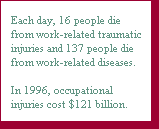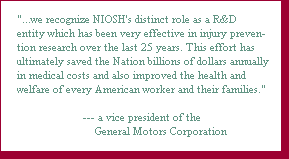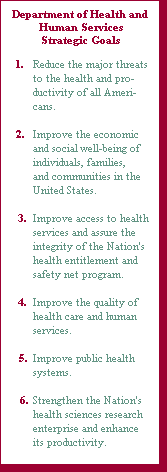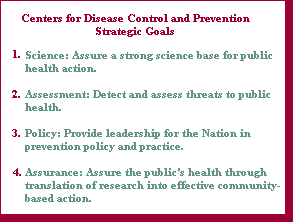Strategic Plan 1997-2002
1998
DHHS (NIOSH) Publication Number 98-137
Report
- Strategic Plan 1997-2002
- NIOSH Strategic Goal 1 — 3
- NIOSH Strategic Goal 4
Strategic Goals
- Conduct a targeted program of research to reduce morbidity, injuries, and mortality among workers in high-priority areas and high-risk sectors.
- Develop a system for surveillance of major occupational illnesses, injuries, exposures, and health hazards.
- Increase occupational disease and injury prevention activities through workplace evaluations, interventions, and recommendations.
- Provide workers, employers, the public, and the occupational safety and health community with information, training, and capacity to prevent occupational diseases and injuries.
Strategic Plan 1997-2002 Report
Background
In 1970, Congress passed the Occupational Safety and Health Act “to assure so far as possible every working man and woman in the Nation safe and healthful working conditions.” In passing this landmark legislation, Congress developed a two-pronged approach to meet this ambitious goal: research concerning the causes of occupational injuries and illnesses and based on that research, the development and enforcement of standards to remove those hazards from the workplace. The Act created the Occupational Safety and Health Administration (OSHA) to perform the enforcement function and the National Institute for Occupational Safety and Health (NIOSH) to perform the research function. NIOSH has dedicated itself to that research function throughout its 25-year history.
Congress has reiterated and enhanced the NIOSH research function twice in the last 20 years with regard to occupational safety and health in mines. With the 1977 amendments to the Coal Mine Health and Safety Act and the 1995 consolidation of the U.S. Bureau of Mines safety and health research with NIOSH, Congress gave NIOSH responsibilities in mining that paralleled its work for the rest of industry.
Specifically, NIOSH has the responsibility to:
- enumerate hazards present in the workplace,
- identify the causes of work-related diseases and injuries,
- evaluate the hazards of new technologies and work practices,
- create ways to control hazards,
- train safety and health professionals, and
- recommend occupational safety and health standards.
The Challenge
Using research to protect workers in a constantly changing work environment.

NIOSH employees face a daunting challenge every day. Although the Nation has made substantial progress toward improving worker protections since 1970, (largely a result of occupational safety and health research), workplace hazards continue to inflict a tremendous toll on this nation in terms of human and economic costs. Each day, an average of 16 people die from work-related acute traumatic injuries, and 137 people die from work-related diseases. In 1996, occupational injuries alone cost $121 billion in lost wages and productivity, administrative expenses, health care, and other costs. Clearly, there is much work to be done.
In addition, it is rare that any NIOSH effort — no matter how important — can, by itself, bring an end to a workplace hazard. The practical impact of the NIOSH program on the workplace largely depends on the actions of employers, employees, and NIOSH partners in other Federal agencies, state and local governments, industry, labor, academia, and community organizations.
This dilemma can be seen in the Department of Health and Human Services (DHHS) Healthy People 2000 program. HHS has described Healthy People as ‘a conceptual model for the Nation . . . that sets the agenda for prevention programs in the public and private sectors. . . “. (emphasis added).
Among the Healthy People objectives for improving the health of this Nation are improvements that will be evidenced at the workplace. These objectives include target levels of improvements in work-related conditions. Examples are reducing work-related deaths and injuries, reducing lost work days and incidences of cumulative trauma and skin disorders, and increasing the number of workplaces with rehabilitation and safety and health programs. (For a complete list of Healthy People objectives, see page 21.)
The work of NIOSH has had and will continue to have an impact on improving health and safety at the workplace; it will therefore help the Nation meet many Healthy People objectives. NIOSH has ongoing efforts to address many of the Healthy People areas of work-related hazards, injuries, illnesses, and deaths (such as musculoskeletal problems, skin diseases, violence in the workplace, employee stress, and back injuries) as well as categories of workers and prevention strategies for mine workers, farm workers, and adolescents. In addition, NIOSH goals for surveillance will assist the overall Healthy People effort by moving toward a more comprehensive database, thereby helping to establish baseline and trend information in the occupational safety and health area. Several Healthy People objectives for the workplace related to State law changes, enforcement, and standard setting that fall outside the NIOSH mandate.
The combined efforts of all sectors are needed to have a positive overall impact on the health of this Nation. As one partner in this effort, we have therefore developed strategies that will contribute to achieving Healthy People objectives, but we have not incorporated specific Healthy People goals into this plan.
As NIOSH develops its plan for moving forward into the next century in a time of fiscal constraints, it must ensure that its resources and efforts are focused on the most important workplace hazards and that the information it gains through research is accessible to its partners in prevention.
NIOSH Strategic Goals
Safety and Health at Work for All People
NIOSH and its employees are ready to meet the challenge of assuring safety and health at work for all people. To accomplish this mission, NIOSH has established four Institute-wide objectives that complement the goals set out by DHHS and the Centers for Disease Control and Prevention (CDC). Note that NIOSH has not attempted to make all of its activities fit within these goals. The Institute has instead looked to those activities that represent the majority of its work.
The four NIOSH goals concern the targeting of research, surveillance, prevention, and information dissemination and training. These four goals represent the broad spectrum of NIOSH work, and the interplay of these goals has formed and will form the NIOSH contribution to realizing the Vision of this Institute — safer and healthier workplaces. Achievement of these goals in the United States can provide a beacon for other countries in the world, many of which are struggling to define occupational safety and health problems and ways to combat them.

Throughout its 25-year history, NIOSH has had proven successes in all of these areas. For example, because of research performed by NIOSH , this Nation has virtually eliminated byssinosis (brown lung) and substantially reduced coal workers’ pneumoconiosis (black lung). NIOSH has also addressed the critical need for occupational safety and health professionals through training for doctors, nurses, industrial hygienists, and engineers. NIOSH efforts have led to the banning of ethylene dibromide (a fruit fumigant and proven human toxin ), an action that protected an estimated 108,000 workers from possible reproductive damage, and recently, NIOSH work with the asphalt paving industry resulted in an agreement with the industry to install ventilation systems on paving machines — thereby reducing worker exposure to asphalt fumes by 80 percent.
As recently stated by a Vice President of the General Motors Corporation, “. . .we recognize NIOSH’s distinct role as a R&D entity which has been very effective in injury prevention research over the last 25 years. This effort has ultimately saved the Nation billions of dollars annually in medical costs and also improved the health and welfare of every American worker and their families.”
To remain successful, NIOSH must continue to integrate efforts in all four strategic goal areas. For example, in 1990 Congress directed NIOSH to expand its efforts directed at health problems affecting construction and agricultural workers. In response, NIOSH developed comprehensive prevention programs by expanding existing NIOSH activities in the areas of surveillance, research, intervention, and information transfer. NIOSH conducted or funded more than 100 such activities to identify, characterize, and control work-related injuries, diseases, and hazards experienced by construction and agricultural workers and to disseminate the information generated from these and other research efforts.
In the end, progress toward the NIOSH Vision can be measured only by a reduction in occupational injuries, illnesses, and fatalities. In fact, the Nation has made measurable progress since the inception of NIOSH. From 1970 to 1995, the rate of workplace fatalities fell by 78%, and the number of workplace deaths has declined by 62%. We have also seen a 25% decline in the rate of occupational injuries and illnesses from 1973 through 1994.
These reductions are the result of the combined efforts of all the NIOSH partners in occupational safety and health: industry, labor, academic researchers, OSHA, MSHA, State and local agencies and others. No single partner can claim exclusive credit for the progress we have made or will make in protecting this Nation’s workers. For if progress is to be made, all of the partners must act — from identifying the causes of disease and injury through controlling or eliminating the hazards or exposures at the worksite. For this reason, NIOSH has not included reductions of specific hazards, injuries, or diseases in its list of goals.

Although we have placed NIOSH activities under each strategic goal, it is difficult to categorize some of our activities as belonging to one goal rather than another. For example, workplace and industry interventions are described here as prevention activities, but we could also describe them as efforts at problem identification or applications of targeted applied research and place them under the surveillance or targeted research goal.
The NIOSH Strategic Goals relate to and complement those of DHHS and CDC.
Much of the work of NIOSH could also be characterized as anticipating the next crisis in the workplace and working to ensure that it does not come to pass. Examples include the following:
- Mine disasters that did not occur because NIOSH engineers developed a new pillar system for longwall mining that has become the worldwide industry standard.
- Firefighter deaths that did not happen because of the lessons learned from a NIOSH fatality investigation.
- Health emergencies avoided because employers and employees called the NIOSH information number and learned that the respirators they were about to use would not protect them from acute toxic exposure.

Events such as these occur every day. We cannot precisely measure the number of workers who benefit, since even they may have no idea that it was knowledge obtained by NIOSH that enabled them to go home at the end of the day. Neither do these events translate easily into measures of NIOSH performance. We acknowledge this fact and are committed to ensuring that these preventive acts continue to occur every day in the future as they have in the past.
